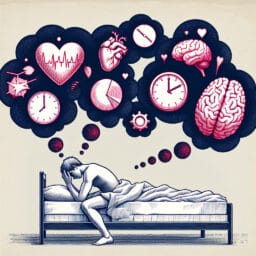
Understanding the Definition and Impact of Wake After Sleep Onset (WASO)
Table of Contents
- Introduction
- Detailed Definition of WASO
- Factors Influencing WASO
- Impact of High WASO
- Ways to Improve WASO
- Conclusion
- Frequently Asked Questions
Introduction
Wake After Sleep Onset (WASO) plays a crucial role in our sleep architecture. By definition, it refers to the total time spent awake after initially falling asleep and before finally waking up for the day. WASO provides key insights into your sleeping pattern, as frequent or long periods of wakefulness occurring after sleep onset may indicate poor sleep quality or even underlying sleep disorders such as sleep apnea or insomnia. A surprising fact is that an increased amount of WASO can result in fragmented sleep leading to daytime sleepiness, reduced performance in daily life activities, and overall poor health. Moreover, understanding and monitoring WASO forms an integral part of comprehensive sleep studies conducted by medical researchers and clinicians. It’s directly related to other significant variables such as total time spent in various sleep stages (especially REM and slow wave sleeps), overall total recording time, and wake times during the night which are often detailed in a typical sleep study report reviewed by your primary care physician or referring specialist. So what influences this critical factor? Factors can range from physiological conditions like restless leg syndrome to behavioral aspects like poor bedtime habits – all contributing to interrupted recovery sleeps that are essential for maintaining good health.
Detailed Definition of WASO
Understanding and optimizing Wake After Sleep Onset (WASO) is integral to achieving sound, restful sleep. WASO reflects the time spent awake after initially falling asleep before finally waking up for the day. It’s measured meticulously in sleep studies using an amalgamation of tools that track sleep onset, total recording time, and total sleep time. Deeper insights into these terms help us comprehend the complex structure of our sleep architecture better. For instance, ‘sleep onset’ is the transition from wakefulness to sleep, marked by a consistent fall in our brain wave activity recorded on an EEG during a sleep study. Further, ‘total recording time’ refers to the total amount of time from lights out till morning alarm – encompassing all periods when patient slept or was fully awake during night hours. Finally, ‘total sleep time’, as it suggests, indicates the cumulative amount of actual sleeping hours excluding any interrupted sleeps or instances of wakefulness occurring during this duration. These metrics collectively paint a comprehensive picture of one’s sleeping pattern – offering insights into potential sleep disorders such as insomnia or obstructive sleep apnea which often result in high WASO values due to increased instances of wakefulness after first falling asleep at night.
Factors Influencing WASO
Age, health conditions, and lifestyle choices can influence your Wake After Sleep Onset (WASO), directly impacting sleep quality. For instance, medical conditions like sleep apnea or restless leg syndrome can lead to increased wakefulness after initially falling asleep. In sleep apnea, interrupted breathing disrupts the sleep cycle causing an increase in the total time spent awake. Similarly, the discomfort associated with restless leg syndrome often causes difficulty staying asleep leading to a high WASO value. Lifestyle habits also play a crucial role in determining WASO values. Poor sleep hygiene practices such as irregular bedtime schedules or exposure to electronic screens before bed can interfere with your ability to fall asleep and stay asleep during the night. Moreover, stimulants like caffeine and alcohol consumed closer to bedtime can cause fragmented sleep patterns resulting in longer wake times during the night which are often detailed in a typical sleep study report reviewed by primary care physicians or referring specialists during follow-up visits.These facts underline the importance of understanding how various factors from our daily life impact our WASO and therefore our overall health outcomes.
| Factor | Explanation | Impact on WASO |
|---|---|---|
| Age | As people age, sleep patterns tend to change, often resulting in increased wakefulness during the night. | Can increase WASO value |
| Health Conditions (Example: Sleep Apnea, Restless Leg Syndrome) | Medical conditions like sleep apnea and restless leg syndrome disrupt the sleep cycle or cause discomfort leading to difficulty staying asleep. | Can significantly increase WASO value |
| Lifestyle Choices (Example: Poor Sleep Hygiene Practices) | Irregular bedtime schedules or exposure to electronic screens before bed can interfere with the ability to fall asleep and stay asleep. | Can increase WASO value |
| Stimulants (Example: Caffeine, Alcohol) | Consumption of stimulants like caffeine and alcohol close to bedtime can cause fragmented sleep patterns. | Can increase WASO value leading to longer wake times during the night |
Impact of High WASO
While delving into the realm of sleep studies and understanding concepts like Wake After Sleep Onset (WASO), it’s pivotal to comprehend how a high WASO score can influence both physical and mental health, subsequently affecting the quality of life. The intricate fabric of our body’s sleep architecture is directly related to crucial aspects of daily life such as productivity, cognitive function and emotional stability. This connection becomes starkly evident in cases where individuals experience WASO due to medical conditions like sleep apnea or restless leg syndrome arthritis. Such patients often exhibit detrimental symptoms ranging from daytime sleepiness to decreased performance in routine tasks – underscoring the clinical significance of good sleep latency.
Consider the case study of a 45-year-old patient who was constantly battling fatigue and impaired focus at work despite maintaining an ostensibly regular bedtime schedule. A detailed review by a sleep specialist revealed that the patient had long periods of wakefulness occurring after initially falling asleep, resulting in poor sleep efficiency. Through comprehensive analysis performed during multiple nights at a sleep clinic, they discovered that he had an alarmingly high WASO score caused by undiagnosed restless leg syndrome arthritis – thus rendering his total time spent asleep far less restorative than it appeared on surface level. With appropriate behavioral therapy intervention geared towards improving his WASO score, not only did this individual notice significant improvement in total amount of restful REM and slow wave sleeps but also experienced enhanced quality during waking hours — proving that understanding and improving WASO does have tangible benefits for overall wellbeing.
Ways to Improve WASO
A crucial aspect of improving WASO lies in integrating effective lifestyle changes and medical interventions, as an optimized sleep onset can pave the way toward enhanced sleep quality. Consider the impact that good sleep hygiene can have on reducing time spent awake after initially falling asleep. Practices like maintaining a consistent bedtime schedule, ensuring a quiet and dark sleep environment, and limiting exposure to electronic devices before bed are instrumental in enhancing total sleep time and minimizing fragmented sleep patterns. Medical conditions such as restless leg syndrome arthritis or sleep apnea insomnia may necessitate interventions from trained professionals including sleep specialists or primary care physicians. Techniques like behavioral therapy may be employed for their clinical significance in managing these disorders. By focusing on cognitive restructuring, stimulus control, and relaxation techniques, this therapy aims to reduce anxiety around falling asleep thus reducing wakefulness occurring during the night hours—a critical measure for decreasing your WASO value. Furthermore, regular check-ups with referring physicians along with detailed reviews of your total recording time on your sleep study report can help monitor progress over time. So while achieving a healthy WASO score might not be an easy task considering various influencing factors mentioned earlier—it’s absolutely feasible with dedicated efforts targeted at understanding your unique sleeping pattern and personalized strategies to improve it.
| Ways to Improve WASO |
|---|
| Integrating effective lifestyle changes and medical interventions |
| Maintaining a consistent bedtime schedule |
| Ensuring a quiet and dark sleep environment |
| Limiting exposure to electronic devices before bed |
| Addressing medical conditions like restless leg syndrome, arthritis, sleep apnea, and insomnia |
| Seeking help from professionals like sleep specialists or primary care physicians |
| Applying techniques like behavioral therapy for cognitive restructuring, stimulus control, and relaxation |
| Regular check-ups with referring physicians and reviewing total recording time on sleep study report |
| Understanding unique sleeping pattern and developing personalized strategies to improve it |
Conclusion
Ever wondered why you wake up feeling exhausted even after clocking in the recommended seven to nine hours of sleep? The culprit could be a high Wake After Sleep Onset (WASO) score. Although often overlooked, WASO plays a significant role in your overall sleep health. It represents the total time spent awake after initially falling asleep and before waking up for the day—a crucial factor directly related to your sleep quality. An increased amount of wakefulness occurring during your total sleep time can disrupt crucial stages of REM and slow wave sleeps, leading to poor sleep efficiency and daytime drowsiness. This fragmented night’s rest could stem from numerous factors—ranging from medical conditions like sleep apnea or restless leg syndrome arthritis to lifestyle habits such as poor bedtime routines or caffeine consumption close to bedtime. By prioritizing good sleep hygiene practices, addressing underlying health concerns with primary care physicians or specialist referrals, and perhaps incorporating behavioral therapy techniques under expert guidance—you can effectively reduce wake time, improve long latency sleeps and achieve better recovery during night hours. Remember, understanding WASO is not only an important element within comprehensive sleep studies conducted by clinicians but also a valuable tool in proactively managing your personal sleeping patterns for optimized daily life performance.


